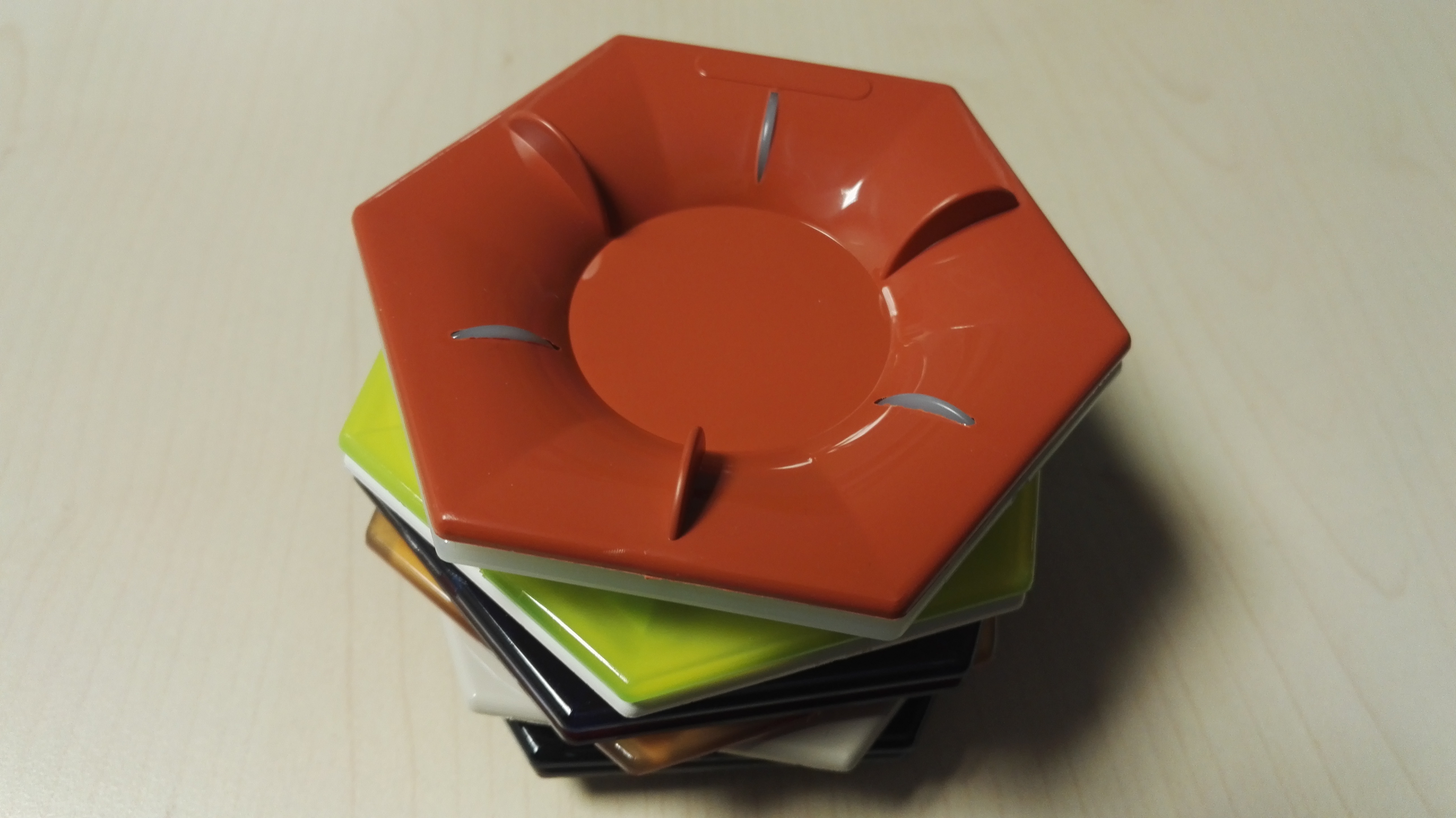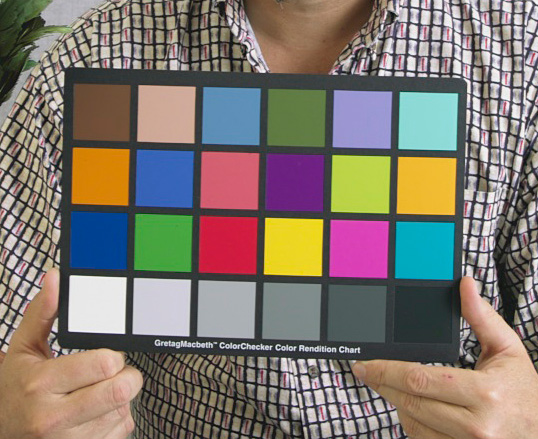Color chart on:
[Wikipedia]
[Google]
[Amazon]

 A color chart or color reference card is a flat, physical object that has many different
A color chart or color reference card is a flat, physical object that has many different
 The ColorChecker, first produced as the "Macbeth ColorChecker" in 1976, is a cardboard-framed arrangement of twenty-four squares of painted samples based on Munsell colors. Its previous maker Gretag–Macbeth was acquired in 2006 by X-Rite.
A ColorChecker chart can be used to manually adjust color parameters (e.g. color temperature) to achieve a desired color rendition. ColorChecker charts are available in different sizes and forms.
The ColorChecker, first produced as the "Macbeth ColorChecker" in 1976, is a cardboard-framed arrangement of twenty-four squares of painted samples based on Munsell colors. Its previous maker Gretag–Macbeth was acquired in 2006 by X-Rite.
A ColorChecker chart can be used to manually adjust color parameters (e.g. color temperature) to achieve a desired color rendition. ColorChecker charts are available in different sizes and forms.
 Standardized IT8 charts, also called IT8 targets, are made by several companies, including Coloraid.de,
Standardized IT8 charts, also called IT8 targets, are made by several companies, including Coloraid.de,
ISBN 978-0-691-25517-0 .

 A color chart or color reference card is a flat, physical object that has many different
A color chart or color reference card is a flat, physical object that has many different color
Color (or colour in English in the Commonwealth of Nations, Commonwealth English; American and British English spelling differences#-our, -or, see spelling differences) is the visual perception based on the electromagnetic spectrum. Though co ...
samples present. They can be available as a single-page chart, or in the form of swatchbooks or color-matching fans.
Typically there are two different types of color charts:
* Color reference charts are intended for color comparisons and measurements. Typical tasks for such charts are checking the color reproduction of an imaging system, aiding in color management
Color management is the process of ensuring consistent and accurate colors across various devices, such as monitors, printers, and cameras. It involves the use of color profiles, which are standardized descriptions of how colors should be disp ...
or visually determining the hue of color. Examples are the IT8 and ColorChecker charts.
* Color selection charts present a palette of available colors to aid the selection of spot color
In offset printing, a spot color or solid color is any color generated by an ink (pure or mixed) that is printed using a ''single run'', whereas a process color is produced by printing a series of dots of different colors.
The widespread offset- ...
s, process colors, paint
Paint is a material or mixture that, when applied to a solid material and allowed to dry, adds a film-like layer. As art, this is used to create an image or images known as a painting. Paint can be made in many colors and types. Most paints are ...
s, pens, crayons, and so on – usually the colors are from a manufacturers product range. Examples are the Pantone and RAL systems.
Color reference charts
Color reference charts are used for color comparisons and measurements such as checking the color reproduction of an imaging system, and calibration and/or profiling of digital input devices such as digital cameras, and scanners and output display systems like printers, monitors and projectors. They are also used by traditional photographers and cinematographers to calibrate cameras that use film and to check the color temperature of the lighting. Color reference cards can also be used to assess light quality, as in thecolor rendering index
A color rendering index (CRI) is a quantitative measure of the ability of a light source to reveal the colors of various objects faithfully in comparison with a natural or standard light source.
''Color rendering'', as defined by the Internat ...
, where reflectance from a set of Munsell samples are evaluated.
Shirley cards
Shirley cards are color reference cards that are used to perform skin-color balance in still photography printing. The industry standard for these cards in North American photography laboratories in the 1940s and 1950s depicted a solitary "Caucasian" female dressed in brightly colored clothes. Very few of these color reference cards showed an adult male as the reference image. Light skin tones therefore served as the recognized skin ideal standard. Stock color film chemistry for still cameras was designed originally with a positive bias toward "Caucasian" skin tones, because of their high levels of reflectivity. By the mid-1990s, Japanese companies redesigned their Shirley cards using data from their own color preference tests. The new reference card featured Japanese women with light, East Asian skin tones. In 1995,Kodak
The Eastman Kodak Company, referred to simply as Kodak (), is an American public company that produces various products related to its historic basis in film photography. The company is headquartered in Rochester, New York, and is incorporated i ...
designed a multiracial norm reference card. This card showed three women (Caucasian, Asian, African) with different skin colors and brightly contrasted clothing.
A similar cinematic calibration technique is known as the China Girl.
ColorChecker charts
 The ColorChecker, first produced as the "Macbeth ColorChecker" in 1976, is a cardboard-framed arrangement of twenty-four squares of painted samples based on Munsell colors. Its previous maker Gretag–Macbeth was acquired in 2006 by X-Rite.
A ColorChecker chart can be used to manually adjust color parameters (e.g. color temperature) to achieve a desired color rendition. ColorChecker charts are available in different sizes and forms.
The ColorChecker, first produced as the "Macbeth ColorChecker" in 1976, is a cardboard-framed arrangement of twenty-four squares of painted samples based on Munsell colors. Its previous maker Gretag–Macbeth was acquired in 2006 by X-Rite.
A ColorChecker chart can be used to manually adjust color parameters (e.g. color temperature) to achieve a desired color rendition. ColorChecker charts are available in different sizes and forms.
IT8 charts
 Standardized IT8 charts, also called IT8 targets, are made by several companies, including Coloraid.de,
Standardized IT8 charts, also called IT8 targets, are made by several companies, including Coloraid.de, Fujifilm
, trading as , or simply Fuji, is a Japanese Multinational corporation, multinational Conglomerate (company), conglomerate headquartered in Tokyo, Japan, operating in the areas of photography, optics, Office supplies, office and Biomedical engine ...
, Kodak
The Eastman Kodak Company, referred to simply as Kodak (), is an American public company that produces various products related to its historic basis in film photography. The company is headquartered in Rochester, New York, and is incorporated i ...
, LaserSoft Imaging. Unlike ColorChecker charts, IT8 charts are supplied with measurement values and can be used to create ICC color profiles by software, ''e.g.'', for digital cameras, to create reproducible color management
Color management is the process of ensuring consistent and accurate colors across various devices, such as monitors, printers, and cameras. It involves the use of color profiles, which are standardized descriptions of how colors should be disp ...
.
Other
Pier Andrea Saccardo proposed this "chromotaxy scale" in 1894, to standardize the naming of colors of plant specimens. Color charts can take custom forms, as for example the calibration target used by the ''Curiosity'' rover for its Mars Hand Lens Imager (MAHLI). The European Pharmacopoeia monograph 2.2.2 is a method to determine the degree of coloration in liquids, applied to pharmacological compounds, drug substances and finished product. It consist in 3 stock solutions, yellow, red, and blue. These are prepared by dissolving in hydrochloride acid ferric chloride, cobalt chloride, or copper sulfate, respectively. The stock solutions are then used in different proportions to prepare five standard solutions, termed B (brown), BY (brownish-yellow), Y (yellow), GY (greenish-yellow), and R (red). Results are given by observation of the test material against the standard solutions, and expressed as less intensely colored as the next color standard (for example, "color of solution colorless to slightly brown-yellow liquid,Color selection charts
Because paints and inks depend for their color onpigment
A pigment is a powder used to add or alter color or change visual appearance. Pigments are completely or nearly solubility, insoluble and reactivity (chemistry), chemically unreactive in water or another medium; in contrast, dyes are colored sub ...
s and dye
Juan de Guillebon, better known by his stage name DyE, is a French musician. He is known for the music video of the single "Fantasy
Fantasy is a genre of speculative fiction that involves supernatural or Magic (supernatural), magical ele ...
s, a reference is needed to match specific combinations of coloring substances in a given matrix against the resulting color. One of the earliest attempts to achieve this goal was the 1692 manuscript Klaer Lightende Spiegel der Verfkonst. It presented a range of watercolor mixtures, but remained relatively unknown, because only one manuscript was produced. Due to the development of the paint and ink industry, the requirement for this kind of chart intensified, and a number of systems are now available, including:
* "DIC Color System Guide" and " Toyo Color Finder," commonly used for spot color
In offset printing, a spot color or solid color is any color generated by an ink (pure or mixed) that is printed using a ''single run'', whereas a process color is produced by printing a series of dots of different colors.
The widespread offset- ...
matching, mostly in Japan
* NCS Palette (Natural Color System)
* Pantone, used for printing and sometimes for paint, fabric, and plastics
* RAL (Reichsausschuß für Lieferbedingungen) "Classic", "Effect", and "Design," used for varnish and powder coating
See also
*Color calibration
The aim of color calibration is to measure and/or adjust the color response of a device (input or output) to a known state. In International Color Consortium (ICC) terms, this is the basis for an additional color characterization of the device ...
* Colour Index International
* Color management
Color management is the process of ensuring consistent and accurate colors across various devices, such as monitors, printers, and cameras. It involves the use of color profiles, which are standardized descriptions of how colors should be disp ...
* Color mapping
* ICC profile
* IT8
* Lenna
Lenna (or Lena) is a standard test image used in the field of digital image processing, starting in 1973. It is a picture of the Swedish model Lena Forsén, shot by photographer Dwight Hooker and cropped from the centerfold of the November ...
* Lists of colors
* Test film
* China Girl
Further reading
* Varichon, Anne (2024). ''Color Charts: A History''. Princeton University Press.References
{{Color topics Color space Shades of color Photography equipment